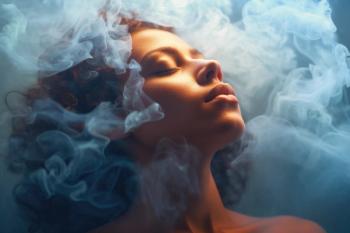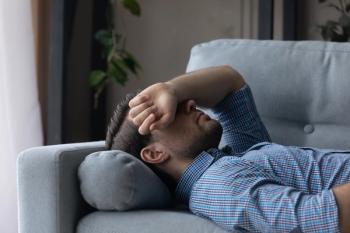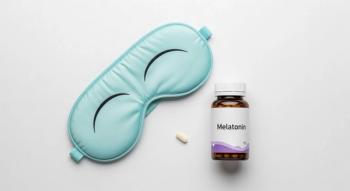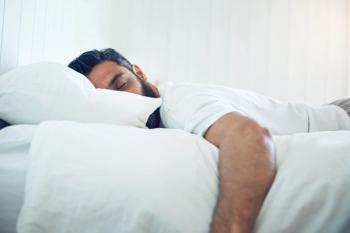
- Psychiatric Times Vol 11 No 7
- Volume 11
- Issue 7
Sleep Disturbances with Substances of Abuse and Dependence
Sleep disorders and substance abuse disorders are widespread acrossthe United States, researchers have found. According to the NationalCommission on Sleep Disorders Research, more than 80 million Americanscomplain of sleep difficulties, while Schuckit and Irwin reportedthe lifetime prevalence of alcohol abuse or dependence to be 13percent and nonalcohol drug abuse, 5.9 percent.
Sleep disorders and substance abuse disorders are widespread acrossthe United States, researchers have found. According to the NationalCommission on Sleep Disorders Research, more than 80 million Americanscomplain of sleep difficulties, while Schuckit and Irwin reportedthe lifetime prevalence of alcohol abuse or dependence to be 13percent and nonalcohol drug abuse, 5.9 percent.
People with substance-related disorders consume psychoactive substancessuch as alcohol, caffeine, stimulants, sedative-hypnotic agentsand nicotine routinely in an effort to achieve the desired effectupon alertness. Obtaining information from patients regardingtheir sleep habits, as well as their use of psychoactive substancesto manipulate sleep and alertness, is an important part of a completehistory.
Alcohol's Effects
Alcohol has known effects upon sleep physiology in both intoxicationand withdrawal. In moderate dosages (3 to 8 ounces), alcohol willinitially shorten sleep latency and decrease REM (dream) sleepin the first half of the night. However, later in the night, REMsleep will rebound and the patient will experience more frequentarousals with fragmentation of sleep. While individuals developtolerance to the sedating effects of alcohol over time, they canlearn to override that tolerance by increasing the amount of alcoholconsumed near bedtime. As the blood alcohol level falls throughoutthe night, the known somatic effects of this falling blood alcohollevel also contribute to the fragmentation of sleep. And for therecovering alcoholic, the effects upon sleep, with a decreasein slow wave sleep and more frequent arousals, may persist foryears.
Alcohol also clearly increases the frequency of upper airway obstruction.With the prevalence of obstructive sleep apnea estimated to beapproximately 4 percent of those aged 40 to 59, it is importantto advise patients of the effects of alcohol upon sleep and breathing.Twenty-four percent of patients age 65 and older have more thanfive apneic events per hour of sleep. Alcohol appears to selectivelydecrease the motor activity of the upper airway muscle dilators,thus increasing the risk of upper airway collapse. In addition,alcohol alters the arousal threshold response to hypoxemia andhypercapnia, elongating the apneic events. Alcohol can induceapneic events not only in snorers, but in healthy asymptomaticmales as well.
A clinical correlation exists between sleep disorder diagnosesand alcohol dependency or abuse, with higher frequency of alcoholismseen in patients with disorders of hypersomnolence (such as sleepapnea syndrome) as well as in those patients with complaints ofinsomnia or poor sleep maintenance.
This correlation is also present in patients with narcolepsy,a disorder defined by its extreme effects on daytime alertness.As many of these patients will need to be treated with psychoactivesubstances, a thorough history of drug and alcohol use, alongwith patient education regarding the effects of alcohol upon sleepand sleepiness, is essential.
It is important to note that the sleepiness that is induced byalcohol is potentiated by sleep deprivation, Zwyghuiz-en-Doorenbosand others reported. This enhancement of alcohol's sedating effectby sleep deprivation raises significant concerns regarding safetywhile driving. Since sleep deprivation may be significant amongpatients with insomnia and other sleep disorders, physicians shouldadvise them of this potentiating effect. The National TransportationSafety Board has found that lethal accidents are in large partaccounted for by the effects of alcohol coupled with sleepiness.Given the obvious public health risks that sleepiness induces,it is extremely important that the public be made aware of boththe hazards of sleepiness and the availability of risk managementprograms.
Stimulant Medications
Stimulant medications such as amphetamines, pemoline (Cylert)and methyl-phenidate (Ritalin) are increasingly used both forsleep disorders such as narcolepsy and idiopathic hypersomnolenceand for psychiatric disturbances such as attention-deficit/ hyperactivitydisorder and depression.
Feinberg and colleagues found that stimulant medications willprolong sleep latency and REM latency and decrease total sleeptime. As tolerance develops to these effects, dosage escalationresults. Careful monitoring of patient use, as well as educationregarding the effects of such medication, is crucial. In withdrawal,stimulants will result in hypersomnia and frequently hyperphagia,as well as affective instability.
Caffeine's Effects
Caffeine, along with the other methyl-xanthines, is probably themost frequently used and abused stimulant agent. The effects ofcaffeine appear to vary, with some individuals being more sensitiveto its effects than others. Ingestion of about a cup of brewedcoffee prior to bedtime appears to significantly prolong sleeplatency when compared with placebo. Total sleep time will be diminished,because arousals and awakenings are more frequent. Caffeine mayeffectively combat sleepiness, though tolerance does appear todevelop with continued use.
Symptoms of anxiety, insomnia, psychomotor excitement and gastrointestinaldisturbances may result from caffeine intoxication. In patientswith those symptoms consuming more than the equivalent of threecups of brewed coffee per day (300 to 450 mg), it is importantto taper the caffeine use as opposed to abrupt withdrawal, whichcan result in headache, gastrointestinal disturbance, sleepinessand marked irritability.
Nicotine's Effects
Evidence suggests that nicotine has a biphasic effect upon alertness.In low dosages it appears to cause sedation, while in higher dosagesstimulation is more commonly experienced. The effects of nicotineand caffeine are often coupled in order to achieve the desiredlevel of alertness. The plasma half-life of nicotine is approximatelytwo hours, which for most smokers results in a fall in concentrationof the drug throughout the night. Sleep laboratory recordingsindicate that chronic smokers have a longer initial sleep latencythan nonsmokers, and that this effect disappears upon cessationof smoking. However, chronic smokers also experience anxiety andmarked restlessness in withdrawal, so that it is often difficultto assess the effects upon sleep. In general, good sleep hygienemeans avoiding tobacco for several hours prior to desired sleeponset.
Agents for Change
Sedative-hypnotic agents are among the most commonly prescribedmedications in the world. Specifically, benzodiazepine agentswill result in a shortening of sleep latency and reduction ofwakefulness during sleep. They appear to alter sleep by bindingto the benzodiazepine GABA receptor and modulating GABA transmission.When these agents are withdrawn, insomnia and sometimes nightmaresmay be seen.
Rebound insomnia may result following discontinuation of shorthalf-life and intermediate half-life agents given for short periodsof time. This can occur following even a single night of administration.Rebound insomnia does not appear to be a problem with short-termuse of the newer hypnotic agent zolpidem (Ambien). While structurallydistinct from the benzodiazepine agents, it too appears to actupon the GABA receptor. Unlike benzodiazepine agents, zolpidemdoes not lead to decreased slow wave sleep. As with all hypnoticagents, pharmacotherapy alone is not the solution for patientswith chronic insomnia, and comprehensive assessments and treatmentplanning are necessary for sustained improvement.
Education regarding the effects of psychoactive substances isclearly indicated. The use of such substances raises significantpublic health concerns, not only when used in an abusive pattern,but when ingested in a socially accepted fashion.
References:
References
1.
Ancoli-Israel S, Kripke DF, Klauber MR, et al. Sleep-disorderedbreathing in community dwelling elderly.
Sleep.
1991;14:486-495.
2.
Cirignotta F, D'Alessandro R, Paritnen M. Prevalence of every-nightsnoring and obstructive sleep apnoeas in 30- to 69-year-old menin Bologna, Italy.
Acta Psychiatr Scand.
1989;79:366-372.
3.
Esther MS, Fredrickson PF, Richardson JW. Association of abnormalalcohol self-screening tests and sleep disorder diagnoses.
SleepRes.
1988;17:274.
4.
Feinberg I, Hibi S, Braun M, et al. Sleep amphetamine effectsin MBPS and normal subjects.
Arch Gen Psychiatry.
1974;31:723-731.
5.
National Commission on Sleep Disorders Research.
Wake upAmerica: A National Sleep Alert. Vol. 1, Report of the NationalCommission on Sleep Disorders Research.
Bethesda, Md.: NationalInstitutes of Health, Jan. 1993.
6.
National Transportation Safety Board.
Safety Study; Fatigue,Alcohol, Other Drugs and Medical Factors in Fatal-to-the-DriverHeavy Truck Crashes. Vol 2.
Washington; 1990: p. 1-447.
7.
Nicholson AN, Pascoe PA. Hypnotic activity of an imidazopyridine(zolpidem).
Br J Clin Pharmacol.
1986;21:205-211.
8.
Rundell OH, Lester BK, Griffiths WJ, Williams HC. Alcohol andsleep in young adults.
Psychopharmacologia.
1972;26:201-218.
9.
Schuckit MA, Irwin M. Diagnosis of alcoholism.
Med ClinNorth Am.
1988;72:1133-1153.
10.
Soldatos CR, Kales JD, Scharf MB, et al. Cigarette smokingassociated with sleep difficulty.
Science.
1980;207:551-553.
11.
Zwyghuiz-en-Doorenbos A, Roehrs T, Lanphere J. Increased daytimesleepiness enhances ethanol's sedative effects.
Neuropsychopharmacology.
1988;1:279-286.
12.
Zwyghuiz-en-Doorenbos A, Roehrs T, Lipschutz L, et al. Effectsof caffeine on alertness.
Psychopharmacol.
1990;100:36-39.
Articles in this issue
over 31 years ago
Hypnotics and the Perception of Wakefulnessover 31 years ago
A Psychiatrist's Primer on Sleep ApneaNewsletter
Receive trusted psychiatric news, expert analysis, and clinical insights — subscribe today to support your practice and your patients.

















